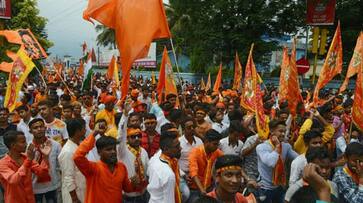Before rushing to analyse why there has been such a consolidation, one piece of data that many tend to ignore will shock you. Between 2014 and 2019, BJP didn't witness a decline in its vote share in a single parliamentary constituency among all 42 of them
From RSS groundwork to Mamata's anti-incumbency, everything under the sun is credited for BJP's massive 18-seat-win. But the real reason was a flawless Hindu consolidation. A consolidation that even post-Muzaffarnagar Uttar Pradesh had not witnessed. Even seats in minority-heavy Malda that saw communal riots voted for the BJP.
A flawless consolidation!
Bengal has a 27.01% Muslim population according to the 2011 census, and unofficially it is 30%. It has been the preferred pie for all parties. First, it was the left and then the TMC who laid its hand on this pie. But with an unprecedented Hindu consolidation for the very first time in Bengal, the Muslim vote bank became irrelevant. Such was the consolidation on religious lines that many say it surpasses the consolidation of 2014 in Uttar Pradesh after the Muzaffarnagar riots sparked off from an inter-religious incident of eve teasing.

Before rushing to analyse why there has been such a consolidation, one piece of data that many tend to ignore will shock you. Between 2014 and 2019, BJP didn't witness a decline in its vote share in a single parliamentary constituency among all 42 of them. BJP's worst performance has been in Baharampur where the Congress won. But even the worst performance of BJP in Bengal witnessed a vote share increase of more than 3%. And then there were super achievers like Raju Bista from Darjeeling who got a whopping 59.2% of the vote share or Babul Supriyo from Asansol who got 51.2% of the vote share. Both constituencies were unhappy with their respective MPs SS Ahluwalia and Babul Supriyo.
Also read: From Laal Salam to Jai Shri Ram: How Bengal changed in 3 big steps
Even in protected constituencies like Jhargram that has 20.11% population belonging the scheduled castes and 29.37% belonging to the scheduled tribes, the BJP candidates registered a win. SC and ST have traditionally been pro-TMC in the jangalmahal area. This became possible only because of their identification as the majority and not as the scheduled caste or tribe. It's the result of a hardcore 'us vs them' complimented with the 'Modi Magic' that sealed an 18 seat win for the BJP in Bengal.

Did Muslims vote for BJP too?
In 66 blocks and municipalities, the Muslim population is over 50%, as per a Census-based study. Of these 66, more than 40 are in three districts of north and central Bengal – Uttar Dinajpur, Malda, and Murshidabad. Raiganj, where the firing over Urdu took place, went to BJP this time. In spite of a minority dominated constituency that falls under Uttar Dinajpur, the BJP saw a vote share jump of 21.74% from its result of 2014. In Malda, out of the two seats, one went to the BJP. Malda North, where the Mulsim population is almost as much as Hindu population, the BJP winning shows either a flawless Hindu consolidation or some amount of Muslims voting for the BJP too. The district overall has 51% Muslim population. Murshidabad constituency, however, went to the Trinamool Congress.
Also read: Mamata Banerjee openly announces Muslim appeasement, compares them to ‘milch cow’
Daribhit (attack on school students), Baduria, Basirhat, Malda (riots) are not names but red letter incidents in Bengal's political history that hardened the anti-Muslim sentiments among a vast majority who never thought themselves a vote bank, nor did any political party. With every denial to observe Saraswati puja in schools and alter Durga Puja immersion dates, the Mamata Banerjee government played into the hands of BJP. A narrative was cemented to the extent that the Hindu consolidation this time in Bengal has been near flawless. With "Since I appease Muslims, I shall attend it 100 times (iftars)", Mamata Banerjee is only worsening her case.
Last Updated May 28, 2019, 10:00 PM IST









![Salman Khan sets stage on fire for Anant Ambani, Radhika Merchant pre-wedding festivities [WATCH] ATG](https://static-gi.asianetnews.com/images/01hr1hh8y86gvb4kbqgnyhc0w0/whatsapp-image-2024-03-03-at-12-24-37-pm_100x60xt.jpg)
![Pregnant Deepika Padukone dances with Ranveer Singh at Anant Ambani, Radhika Merchant pre-wedding bash [WATCH] ATG](https://static-gi.asianetnews.com/images/01hr1ffyd3nzqzgm6ba0k87vr8/whatsapp-image-2024-03-03-at-11-45-35-am_100x60xt.jpg)


